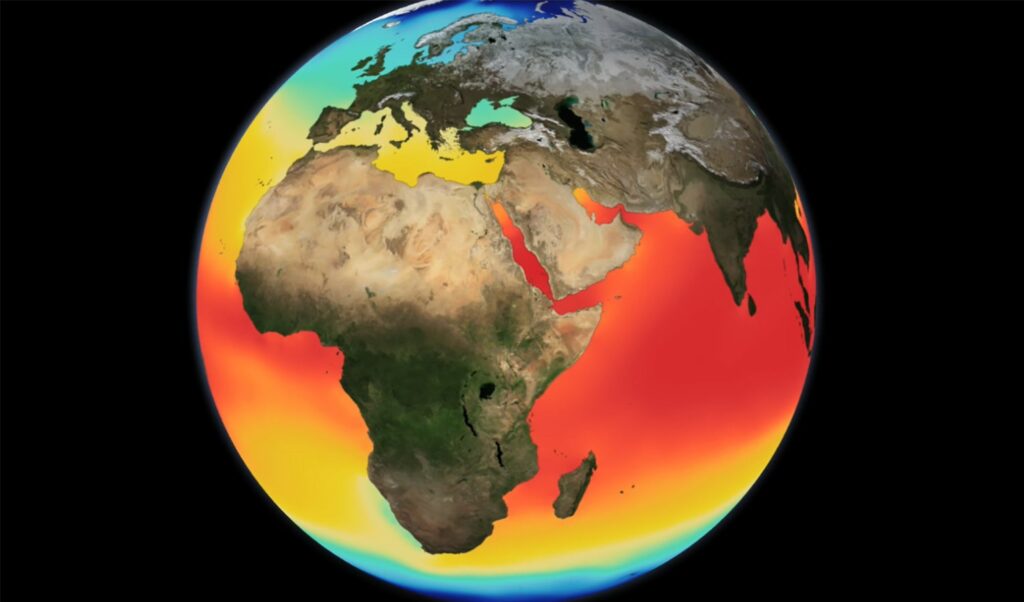The Helmholtz Representation Model for Climate Science (HClimRep) project aims to revolutionize climate modeling by integrating advanced AI techniques and high-performance computing. This groundbreaking initiative focuses on developing a comprehensive AI-based climate model that captures complex interactions between the atmosphere, ocean, and sea ice across seasonal to decadal timescales.
By leveraging the success of AtmoRep, an AI model for atmospheric dynamics, HClimRep will extend this approach to include higher vertical levels and different Earth system compartments. This model will utilize large-scale transformer-based AI, optimized for GPU efficiency, to emulate first-principle climate simulations at significantly lower computational costs. This approach not only enhances computational efficiency but also enables extensive numerical experimentation and uncertainty quantification through „what if“ scenarios.

The project’s primary goals include overcoming challenges in reliable long-term AI-based simulations, developing a foundational model for ocean and sea ice dynamics and stratospheric tracer transport, and creating an enhanced climate model that supports multi-grid and multi-resolution inputs. HClimRep will also test the model’s ability to simulate future climates by exploring learned representations of present-day climate variables.
HClimRep will contribute to the development of new climate services with unprecedented capabilities, forming a cornerstone of a future comprehensive AI-based Earth system model. The project will address key scientific questions, manage immense computational demands, and ensure scalability and robustness of the model. Through its innovative approach, HClimRep aims to establish world leadership in AI-driven climate science and support informed decision-making in climate adaptation and policy.

Downstream applications that will be addressed in HClimRep are:
Seasonal-to-Decadal Forecasting for Stratospheric Tracers
This task focuses on predicting changes in the stratosphere, specifically tracking the behavior of important gases like ozone, water vapor, and methane. By simulating their chemical interactions and decay rates, the model will help monitor future changes in the stratosphere, contributing to climate assessments by bodies like the IPCC. This will provide critical data on phenomena like stratospheric warmings and the Quasi-Biennial Oscillation, which are challenging to model with traditional methods.
Counterfactual Scenarios for Marine Heatwaves
OceanRep and HClimRep will be used to simulate hypothetical scenarios of marine heatwaves under different climate conditions. This will help researchers understand how climate variability impacts the intensity, duration, and geographical distribution of these heatwaves. The improved computational efficiency of AI models compared to traditional physics-based models will make these simulations more accessible and dynamic, enabling scientists and policymakers to better engage with and respond to climate change impacts.
Hydrological Cycle Predictions
The project will integrate HClimRep with high-resolution hydrological models to improve the predictability of water availability and extreme weather events like floods and droughts. This involves statistical downscaling and bias correction techniques to refine predictions from medium-range weather forecasts to seasonal and climate timescales. Accurate hydrological predictions are crucial for managing agricultural productivity and assessing flood and drought risks, addressing a significant source of uncertainty in climate modeling .
These downstream tasks will demonstrate the capabilities of HClimRep, offering practical applications that enhance our understanding and response to climate dynamics.
The HClimRep project is organized into 10 work packages (WPs). The project spans two phases, with foundational model extensions in phase 1 and the construction of a novel, multi-scale and multi-compartment model in phase 2.
WP 1:
Onboaring
Objective:
Build a community, provide training, support project partners, and organize a hackathon.
WP 2:
AtmoRep Extension to the stratosphere (StratoRep)
Objective:
Extend AtmoRep to include stratospheric data and tracers, develop training concepts, and evaluate model performance.
WP 3:
OceanRep Prototype Development
Objective:
Develop processing strategies for ocean model data, pre-train OceanRep, build a sea ice component, and evaluate the model.
WP 4:
Enable long-term Simulations
Objective:
Develop strategies for long-term simulations of AtmoRep and OceanRep for seasonal to decadal timescales.
WP 5:
HClimRep Concept Development
Objective:
Develop the model architecture and training strategies for multi-resolution, multi-model integration.
WP 6:
HClimRep Core Model Development
Objective:
Implement HClimRep code, perform test runs, and optimize training performance.
WP 7:
Pre-training of HClimRep
Objective:
Supervise pre-training experiments, monitor performance, and evaluate model checkpoints.
WP 8:
Exploration of Downstream Tasks
Objective:
Develop embedding networks for downstream applications, fine-tune, and evaluate results.
The following two work packages span across the entire project duration:
WP 9:
Data Management
Objective:
Manage input and output data, prepare data publications, and ensure data accessibility.
WP 10:
Project Coordination
Objective:
Coordinate project activities, maintain the project website, organize meetings, and monitor progress.
The HClimRep team is currently learning how to use and develop the AtmoRep foundation model. AtmoRep forms the basis of HClimRep and serves as a prototype of a foundation model for the Earth system. First training runs with an AtmoRep version that has been adapted to the ocean have been performed, and investigations are ongoing how to best achieve stable long-term rollouts and stratospheric tracer simulations. A data management plan has been created and several datasets have been collected at JSC and partner institutions. A computing time application for JUWELS Booster has been written and the HClimRep compute project is starting in November 2024.